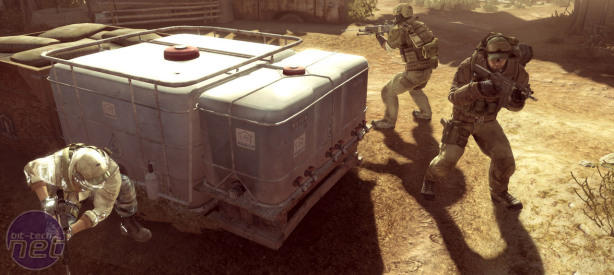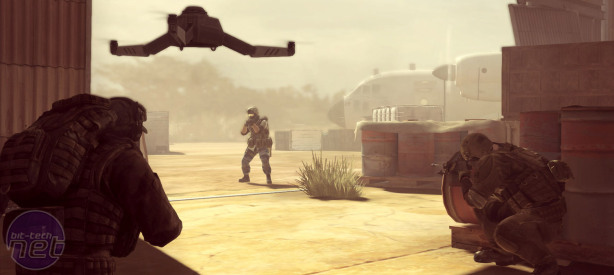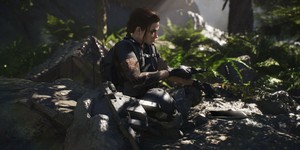
As it is the majority of your time will be spent having straight up fire-fights, so it’s good the controls are far more responsive than previous Ghost Recon games. Enemies are downed quickly, as are you if caught in the open, but a simple and effective cover system ensures this happens rarely. When downed you can be revived by team-mates and generally are. On normal mode GR: FS is a generally easy game, with only a couple of spots offering much of a challenge.
The campaign is a different experience when tackled with three other human players online (it can also be played by two players split-screen, though annoyingly you can’t then connect with two more online). The initial games we played were disorganised, hectic affairs with the normal difficulty setting proving a bit of a challenge, but within the space of a few days players had got a better understanding of the game and we were breezing through levels. This prompted us to try the hardest difficulty, where we were happy to find out that impeccable coordination is required to succeed.
When it comes to online multiplayer, GR: FS is all about objective-based teamwork. Conflict features a host of changing objectives, Decoy has three objectives in play at one time but only one is genuine and will earn the team points, Saboteur is a glorified CTF with a bomb that needs to be placed in the enemy’s base, and Siege has teams take turns to attack and defend with only one life per team member per round. There’s also a survival mode called Guerilla that punctuates the waves of baddies with stealth sections for a bit of much needed variety.
The scoring system places the emphasis firmly on teamwork by awarding a paltry amount of points for kills compared to what you get for completing objectives, and it works, at least in the games we played. Initial rounds are typically full of lone wolves running round racking up kills, but after consistently being on the losing side as a result, most people realise their folly and alter their approach accordingly.
A routine ranking system awards credits for weapon and gadget upgrades. This is bolstered by the ridiculous amount of gun customisation options offered by Gunsmith, though it’s hard to muster much excitement for the claimed two million possibilities when all you’ll really notice is the sight and barrel attachment. But despite being completely superfluous, it’s undeniably fun swishing the bits about with hand gestures using the Kinect, and surely someone out there will enjoy getting to choose their gun’s trigger.
Everything looks great, with no obvious screen tear or texture pop in and aggressive presentation throughout. Steadicam style transitions are used whenever you sprint, run to cover, are under suppressing fire or hop over walls. It creates smooth transitions between actions and eliminates any jarring breaks of momentum that remind us we’re playing a game.
Audio wise, it’s the best we’ve heard since Battlefield 3. Guns are deafeningly bassy and bullets cut through the air with pinpoint directional sound. The atmospheric sounds-capes are particularly good, with car horns and tannoy speakers adding to the bustle of a busy Pakistani street, while screaming winds combined with cries of confusion add to the intensity of a sandstorm.
The identity of the Ghost Recon series is less defined with the release of Future Soldier and it’s a shame to see the reduction of strategic elements in favour of a more action-orientated approach. However, there’s still a certain rhythm to the game that’s unlike most shooters, and the unique gadgets bring an extra layer of fun. Add four-player co-op and a truly team-based multiplayer mode to the mix and GR: FS is a decent offering from Ubisoft, just not the one we hoped for.
The campaign is a different experience when tackled with three other human players online (it can also be played by two players split-screen, though annoyingly you can’t then connect with two more online). The initial games we played were disorganised, hectic affairs with the normal difficulty setting proving a bit of a challenge, but within the space of a few days players had got a better understanding of the game and we were breezing through levels. This prompted us to try the hardest difficulty, where we were happy to find out that impeccable coordination is required to succeed.
When it comes to online multiplayer, GR: FS is all about objective-based teamwork. Conflict features a host of changing objectives, Decoy has three objectives in play at one time but only one is genuine and will earn the team points, Saboteur is a glorified CTF with a bomb that needs to be placed in the enemy’s base, and Siege has teams take turns to attack and defend with only one life per team member per round. There’s also a survival mode called Guerilla that punctuates the waves of baddies with stealth sections for a bit of much needed variety.
The scoring system places the emphasis firmly on teamwork by awarding a paltry amount of points for kills compared to what you get for completing objectives, and it works, at least in the games we played. Initial rounds are typically full of lone wolves running round racking up kills, but after consistently being on the losing side as a result, most people realise their folly and alter their approach accordingly.
Click to enlarge
A routine ranking system awards credits for weapon and gadget upgrades. This is bolstered by the ridiculous amount of gun customisation options offered by Gunsmith, though it’s hard to muster much excitement for the claimed two million possibilities when all you’ll really notice is the sight and barrel attachment. But despite being completely superfluous, it’s undeniably fun swishing the bits about with hand gestures using the Kinect, and surely someone out there will enjoy getting to choose their gun’s trigger.
Everything looks great, with no obvious screen tear or texture pop in and aggressive presentation throughout. Steadicam style transitions are used whenever you sprint, run to cover, are under suppressing fire or hop over walls. It creates smooth transitions between actions and eliminates any jarring breaks of momentum that remind us we’re playing a game.
Click to enlarge
Audio wise, it’s the best we’ve heard since Battlefield 3. Guns are deafeningly bassy and bullets cut through the air with pinpoint directional sound. The atmospheric sounds-capes are particularly good, with car horns and tannoy speakers adding to the bustle of a busy Pakistani street, while screaming winds combined with cries of confusion add to the intensity of a sandstorm.
The identity of the Ghost Recon series is less defined with the release of Future Soldier and it’s a shame to see the reduction of strategic elements in favour of a more action-orientated approach. However, there’s still a certain rhythm to the game that’s unlike most shooters, and the unique gadgets bring an extra layer of fun. Add four-player co-op and a truly team-based multiplayer mode to the mix and GR: FS is a decent offering from Ubisoft, just not the one we hoped for.
-
Overall75 / 100


MSI MPG Velox 100R Chassis Review
October 14 2021 | 15:04











Want to comment? Please log in.